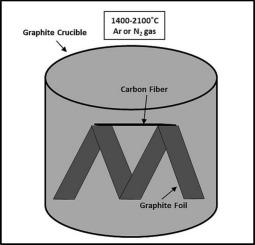热处理聚丙烯腈碳纤维的表征
IF 5.1
3区 材料科学
Q2 MATERIALS SCIENCE, COATINGS & FILMS
引用次数: 0
摘要
本研究研究了聚丙烯腈(PAN)碳纤维的石墨化过程,将商业纤维在1400至2100°C的温度下,以100°C的增量进行热处理,使用氩气或氮气气氛。利用x射线衍射、扫描电镜和拉曼光谱分析了两种商用碳纤维的结晶度、表面形貌和晶格参数的变化。结果表明,随着热处理温度的升高,表面形貌变化很小;结晶度明显提高。结晶度的变化更强烈地依赖于温度而不是气体气氛或纤维类型。在中等热处理温度下(1600-1800°C),氩气处理的纤维表现出轻微的石墨化倾向。石墨化程度在2100℃时达到最高。晶粒尺寸随着D1与G拉曼峰强度比的增大而增大,在~1800℃左右达到峰值,之后强度比开始减小。这种行为与法拉利的三阶段碳结晶模型一致,与Marie-Mering石墨化程度模型和Brubaker的积分绝对微分模型一致,这些模型都描述了从无定形到石墨化结构的转变。在较高的热处理温度下,大气和纤维类型之间的变化被测量到收敛到相似的石墨化水平。本研究评估了商品级碳纤维在热处理后的渐进变化。本文章由计算机程序翻译,如有差异,请以英文原文为准。

Characterization of thermally heat-treated polyacrylonitrile carbon fibers
This study investigates the graphitization process of polyacrylonitrile (PAN) carbon fibers by subjecting commercial fibers to thermal heat treatment at temperatures ranging from 1400 to 2100 °C in 100 °C increments, using either argon or nitrogen gas atmospheres. Changes in crystallinity, surface morphology, and lattice parameters were analyzed for two commercial carbon fibers using X-ray diffraction, scanning electron microscopy, and Raman spectroscopy. Results indicated minimal changes in surface morphology with increasing heat-treatment temperature; however, crystallinity significantly increased. Crystallinity changes were more strongly dependent on temperature rather than gas atmosphere or fiber type. At intermediate heat-treatment temperatures (1600–1800 °C), fibers treated in argon showed a slight preference for graphitization. The highest level of graphitization was measured at 2100 °C. Crystallite size increased as the intensity ratio of the D1 to G Raman peaks increased, reaching a peak around ~1800 °C, after which the ratio started to decrease. This behavior aligns with Ferrari's three-stage model of carbon crystallization and is consistent with both the Marie-Mering degree of graphitization and Brubaker's Integrated Absolute Differential models, all of which describe the transformation from an amorphous to a more graphitic structure. At the higher heat-treatment temperatures, the changes between atmospheres and fiber types were measured to converge to similar levels of graphitization. This study evaluates the progressive change in commercial grade carbon fibers when heat-treated.
求助全文
通过发布文献求助,成功后即可免费获取论文全文。
去求助
来源期刊

Diamond and Related Materials
工程技术-材料科学:综合
CiteScore
6.00
自引率
14.60%
发文量
702
审稿时长
2.1 months
期刊介绍:
DRM is a leading international journal that publishes new fundamental and applied research on all forms of diamond, the integration of diamond with other advanced materials and development of technologies exploiting diamond. The synthesis, characterization and processing of single crystal diamond, polycrystalline films, nanodiamond powders and heterostructures with other advanced materials are encouraged topics for technical and review articles. In addition to diamond, the journal publishes manuscripts on the synthesis, characterization and application of other related materials including diamond-like carbons, carbon nanotubes, graphene, and boron and carbon nitrides. Articles are sought on the chemical functionalization of diamond and related materials as well as their use in electrochemistry, energy storage and conversion, chemical and biological sensing, imaging, thermal management, photonic and quantum applications, electron emission and electronic devices.
The International Conference on Diamond and Carbon Materials has evolved into the largest and most well attended forum in the field of diamond, providing a forum to showcase the latest results in the science and technology of diamond and other carbon materials such as carbon nanotubes, graphene, and diamond-like carbon. Run annually in association with Diamond and Related Materials the conference provides junior and established researchers the opportunity to exchange the latest results ranging from fundamental physical and chemical concepts to applied research focusing on the next generation carbon-based devices.
 求助内容:
求助内容: 应助结果提醒方式:
应助结果提醒方式:


